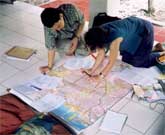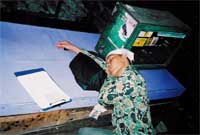This page lists some of the epidemiological reports to which Elizabeth Pisani has contributed, and provides links to full text versions. Many of these are published by national governments and international organisations, who are the copyright holders. More recent publications may be available on the websites of the respective organisations. |
AIDS in Asia: Face the Facts |
| Monitoring the AIDS Pandemic, Bangkok, 2004 |
Prepared on behalf of the MAP network, and association of epidemiologists working independently of institutional affiliations, this report provides a comprehensive analysis of trends in HIV infection and the behaviours that drive it in Asia. Based on published and unpublished data, the report argues that there is evidence that programmes providing appropriate services to a high proportion of the drug injectors, men who have sex with men and men and women who buy and sell sex will effectively stem the epidemic in Asia. |
Evaluation of the World Bank’s
Assistance in Responding to the AIDS
Epidemic:
Indonesia Case Study |
World Bank Operations Evaluation Department |
| A critical appraisal of the World Bank's response to HIV in Indonesia. This document, commissioned by the World Bank's internal evaluation department, investigates what was known of the epidemiology of HIV in Indonesia at the time of a World Bank loan to the country in the mid 1990s. It concludes that the facts did not justify the lending, and finds that lack of technical support and management oversight led to the failure of the loan, which was eventually withdrawn. |
Ancaman HIV/AIDS di Indonesia Semakin Nyata, Perlu Penanggulangan Lebih Nyata |
Indonesian National AIDS Commission, Jakarta, 2002 |
Second report on the national HIV situation in Indonesia. This includes significantly more behavioural surveillance data than previously reported, and makes a clear call for a response that is more appropriately targeted at the behaviours driving the local epidemic, in particular drug injection and commercial sex. Available in Bahasa Indonesia only. |
HIV/AIDS and other STIs in Indonesia: Challenges and Opportunities for Action, 2001 |
| Indonesian National AIDS Commission, Jakarta, 2001 |
In late 2001, Indonesia’s HIV surveillance working group for the first time published a summary of the national HIV situation, based on data generated by the biological and behavioural surveillance systems. It pointed to the growing importance of drug injection in spreading the infection in Indonesia. Available in English and Bahasa Indonesia. |
HIV/AIDS in Bangladesh: Where is it going? |
Bangladesh National AIDS/STD Programme, Dhaka, 2003 |
A report that brings together behavioural and biological surveillance data.about HIV and associated risk in Bangladesh for the first time. The report indicates that high levels of risk behaviour provide fertile ground for potentially rapid growth of HIV despite current low levels of prevalence. |
The Epidemiology of HIV at the start of the 21st Century: A review of the evidence |
UNICEF, New York, 2003 |
A review of the epidemiological evidence that underpins the implications of HIV for children, young people and mothers. The work -- which uses rigorous examination of data to distinguish what we know from what we merely assume to be true -- provides the technical background for a major rethink of UNICEF’s strategy in the field of HIV prevention and care world-wide. |
Report on the global HIV/AIDS epidemic, June 2000 |
UNAIDS, Geneva 2000 |
This comprehensive report on the epidemiology of HIV is based on data drawn from around the world – much of it not previously published. It uses these data to highlight the inevitable impact of the epidemic on human welfare, to question the adequacy of current prevention approaches and to argue for a more efficient use of resources. Published for the International Conference on HIV and AIDS, Durban, 2000 |
Report on the global HIV/AIDS epidemic, June 1998 |
UNAIDS, Geneva 1998 |
The first of UNAIDS biennial reports on the epidemiology of HIV, this widely-read document uses data from around the world to emphasise the importance of increased prevention efforts. It draws attention to areas in which clear policy leadership is needed. Published for the International Conference on HIV and AIDS, Geneva, 1998 |
HIV and AIDS in Latin America and the Caribbean: an epidemic with many faces |
Monitoring the AIDS Pandemic /PAHO, Washington DC, 2000 |
The diversity of HIV epidemics in the Latin American and the Caribbean is often glossed over in wider global reports. This document focuses on the different epidemic dynamics in the region, and highlights some of the information gaps that stand in the way of planning for effective HIV prevention and care. It makes policy recommendations to meet future challenges. Published by the MAP network. |
The United States Responds to the Global AIDS Pandemic |
SYNERGY/USAID, Washington 2001 |
Commissioned by the National Security Council, this document analyses the goals of the U.S. and international response to HIV/AIDS, and looks at concrete targets needed to meet those goals. It examines resource requirements, and points to massive gaps in the understanding of the relationships between programme costs, coverage and impact. |





